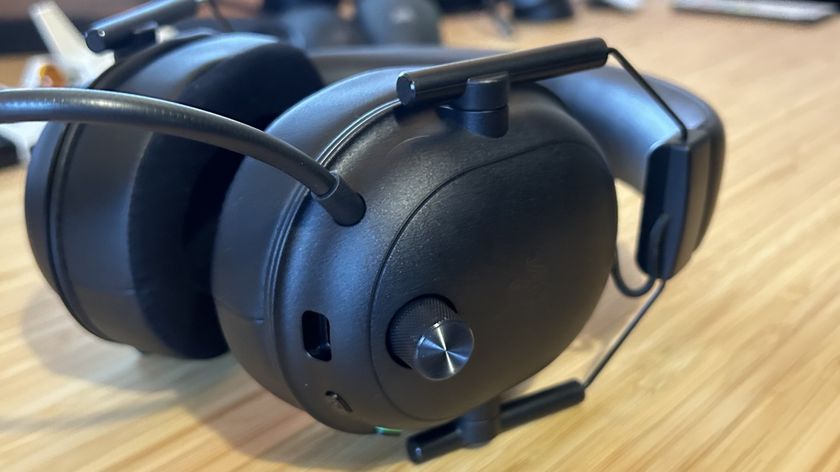Which virtual reality headset is right for you?
HTC Vive: The facts
Release date: April 2016
Price: $799/£689 (excluding shipping)
An unexpected curveball from Valve, the Steam HTC Vive is the most direct competitor to Oculus Rift. Once again requiring a powerful gaming PC to run, but coming with the added bonus of working with Linux and Mac, the Vive is an intimidating contender in the VR race. While Oculus has been the go-to headset for many devs so far, the Vive not only has the advantage of Steam integration, but also has a pair of sensors that map out your location in a 15ft by 15ft physical space. This effectively gives you a full 360 degree world to experience, and a ‘real’ space to wander around in virtual reality. If you move the coffee table, that is.

Visuals come courtesy of a 1200 by 1280 pixel screen for each eyeball and the same refresh rate of 90fps as the Oculus Rift. Sensors on the front of the Vive ensure that you don’t walk into the wall, a helpful grid appearing in your virtual world when you get too close to your real-life architecture and there's a camera on the front to allow you to actually see the room or take advantage of augmented reality tech. This is the only complete package too with each box containing the headset, room sensors and two unique Vive controllers. This might be a premium price point at $799 but it's the only VR offering that delivers everything you need. Plus, every Vive comes with three games: Job Simulator, Fantastic Contraption and Google's Tilt Brush.

HTC Vive: The controllers
The Vive’s controllers are an intriguing addition to the VR line up. Like a halved Steam controller, there’s a round haptic sensor on each stick, as well as a trigger on the underside. It’s the trigger that’s your grip here, much like with PlayStation VR, and the wands are once again lightweight enough to disappear from your thoughts once you’re wearing the headset. The tops might look a little bizarre, but the spatial tracking is second-to-none.

As there’s no need to use buttons to move around due to the headset’s position-tracking abilities, the controllers can focus on being pure hand replacements. In the screen between games during my demo, I looked down to see the controllers appearing in game. With a colour wheel on the left sensor, I cautiously chose a shade and pressed. A shiny red balloon happily inflated from the end of the stick, which I then, very naturally, batted away with the same hand. The sticks are also perfect for Google's Tilt Brush which is basically Microsoft Paint on VR steroids where you can create in 3D space. Of course I didn't try to sketch a life-sized Batman to stand next to. Ahem.
HTC Vive : The experience
As terrifying as Kitchen was, and as immersive as Oculus Touch managed to be, it’s my Vive experience that stands out most. From a white room, I was transported to the bottom of the sea to wander a wreck. The shadows of stingrays glided across the deck and if I gazed up, I could see the sun dappling the surface of the water. Despite being aware of the wires attached to the back of my head, it was the most immersed I’ve ever been in virtual reality. When a giant blue whale passed by, I blinked and I dodged its tail, my heart in my mouth. If something horror-related had happened at that moment, I wouldn’t have known how to cope.

The crystal clear visuals make you happily forget everything outside your simulated world. Even the grid that gently reminds you to stay ‘between the lines’ isn’t too obtrusive. When it came to the interactive Aperture Science demo, I had a giddy old time attempting to fix Portal 2’s Atlas, but it was the arrival of GLaDOS that really convinced me on the future of VR. The opportunity to explore a well-known and much-loved game world, actually from the inside, is just an irresistible hook. Even though I was only wandering around in one small room of Aperture, it felt like the rest of its world was only outside the door. And then the walls fell down…
Sign up to the 12DOVE Newsletter
Weekly digests, tales from the communities you love, and more
Louise Blain is a journalist and broadcaster specialising in gaming, technology, and entertainment. She is the presenter of BBC Radio 3’s monthly Sound of Gaming show and has a weekly consumer tech slot on BBC Radio Scotland. She can also be found on BBC Radio 4, BBC Five Live, Netflix UK's YouTube Channel, and on The Evolution of Horror podcast. As well as her work on GamesRadar, Louise writes for NME, T3, and TechRadar. When she’s not working, you can probably find her watching horror movies or playing an Assassin’s Creed game and getting distracted by Photo Mode.













